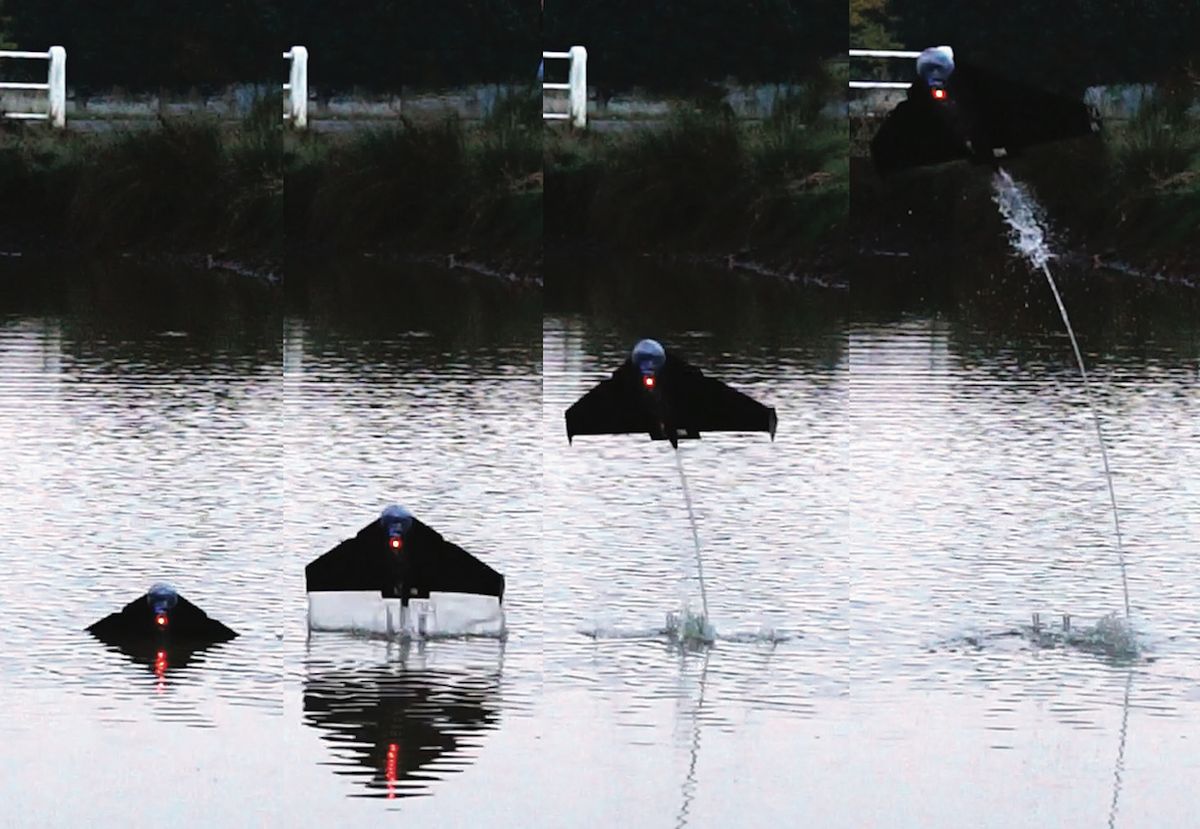At ICRA 2015, the Aerial Robotics Lab at the Imperial College London presented a concept for a multimodal flying swimming robot called AquaMAV. The really difficult thing about a flying and swimming robot isn’t so much the transition from the first to the second, since you can manage that even if your robot is completely dead (thanks to gravity), but rather the other way: going from water to air, ideally in a stable and repetitive way. The AquaMAV concept solved this by basically just applying as much concentrated power as possible to the problem, using a jet thruster to hurl the robot out of the water with quite a bit of velocity to spare.
In a paper appearing in Science Robotics this week, the roboticists behind AquaMAV present a fully operational robot that uses a solid-fuel powered chemical reaction to generate an explosion that powers the robot into the air.
The 2015 version of AquaMAV, which was mostly just some very vintage-looking computer renderings and a little bit of hardware, used a small cylinder of CO2 to power its water jet thruster. This worked pretty well, but the mass and complexity of the storage and release mechanism for the compressed gas wasn’t all that practical for a flying robot designed for long-term autonomy. It’s a familiar challenge, especially for pneumatically powered soft robots—how do you efficiently generate gas on-demand, especially if you need a lot of pressure all at once?
An explosion propels the drone out of the water
There’s one obvious way of generating large amounts of pressurized gas all at once, and that’s explosions. We’ve seen robots use explosive thrust for mobility before, at a variety of scales, and it’s very effective as long as you can both properly harness the explosion and generate the fuel with a minimum of fuss, and this latest version of AquaMAV manages to do both:
The water jet coming out the back of this robot aircraft is being propelled by a gas explosion. The gas comes from the reaction between a little bit of calcium carbide powder stored inside the robot, and water. Water is mixed with the powder one drop at a time, producing acetylene gas, which gets piped into a combustion chamber along with air and water. When ignited, the acetylene air mixture explodes, forcing the water out of the combustion chamber and providing up to 51 N of thrust, which is enough to launch the 160-gram robot 26 meters up and over the water at 11 m/s. It takes just 50 mg of calcium carbide (mixed with 3 drops of water) to generate enough acetylene for each explosion, and both air and water are of course readily available. With 0.2 g of calcium carbide powder on board, the robot has enough fuel for multiple jumps, and the jump is powerful enough that the robot can get airborne even under fairly aggressive sea conditions.

Next step: getting the robot to fly autonomously
Providing adequate thrust is just one problem that needs to be solved when attempting to conquer the water-air transition with a fixed-wing robot. The overall design of the robot itself is a challenge as well, because the optimal design and balance for the robot is quite different in each phase of operation, as the paper describes:
For the vehicle to fly in a stable manner during the jetting phase, the center of mass must be a significant distance in front of the center of pressure of the vehicle. However, to maintain a stable floating position on the water surface and the desired angle during jetting, the center of mass must be located behind the center of buoyancy. For the gliding phase, a fine balance between the center of mass and the center of pressure must be struck to achieve static longitudinal flight stability passively. During gliding, the center of mass should be slightly forward from the wing’s center of pressure.
The current version is mostly optimized for the jetting phase of flight, and doesn’t have any active flight control surfaces yet, but the researchers are optimistic that if they added some they’d have no problem getting the robot to fly autonomously. It’s just a glider at the moment, but a low-power propeller is the obvious step after that, and to get really fancy, a switchable gearbox could enable efficient movement on water as well as in the air. Long-term, the idea is that robots like these would be useful for tasks like autonomous water sampling over large areas, but I’d personally be satisfied with a remote controlled version that I could take to the beach.
“Consecutive aquatic jump-gliding with water-reactive fuel,” by R. Zufferey, A. Ortega Ancel, A. Farinha, R. Siddall, S. F. Armanini, M. Nasr, R. V. Brahmal, G. Kennedy, and M. Kovac from Imperial College in London, is published in the current issue of Science Robotics.
Evan Ackerman is a senior editor at IEEE Spectrum. Since 2007, he has written over 6,000 articles on robotics and technology. He has a degree in Martian geology and is excellent at playing bagpipes.



